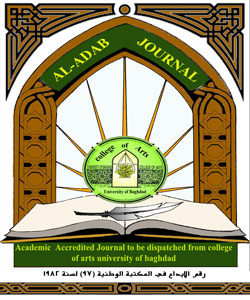A Cognitive Semantic Analysis of Milton's 'Paradise Lost'
DOI:
https://doi.org/10.31973/aj.v0i113.1437Keywords:
/Abstract
Although the field of natural language processing has made considerable strides in the automated processing of standard language, the language of poetry still causes great difficulty. Normally, when we understand human language, we combine the meaning of individual words into larger units in a compositional manner. However, understanding a poem often involves an interpretive adjustment and different conceptualisation strategies of individual words.
This paper aims at exploring the cognitive and semantic bases of Milton's masterpiece 'Paradise Lost' through a combination of theoretical work, corpus analysis, and experimental techniques. The paper hypothesizes that the so-called 'figures of speech' are not mere linguistic devices serving ornamental or literary purposes but correspond to mental 'figures' grounded in cognition. By locating the source of figurativeness in human cognitive make-up, recent research has decisively moved away from the idea that non-literal language constitutes a departure from a linguistic norm.
A question that is not frequently addressed in the literature is the degree to which the operation of the 'poetics of mind' (Gibbs 1994) interacts with linguistic and non-linguistic knowledge, i.e. how it correlates with the semantics-pragmatics distinction. Perhaps among the most important conclusions is that the phenomena classified under each of the tropes do not necessarily constitute a natural class but form rather a continuum which cross-cuts the semantics-pragmatics borderline
Downloads
References
• Bradford, R. (2001). The complete critical guide to John Milton. London: Routledge
• Clausner, T. C., & Croft, W. (1999). Domains and image-schemas. Cognitive Linguistics 10, pp. 1-31.
• Croft, W., & Cruse, D. A. (2004). Cognitive linguistics. Cambridge: Cambridge University Press.
• Evans, V. (2007). A glossary of cognitive linguistics. Edinburgh: Edinburgh University Press.
• Evans, V., & Green, M. (2006). Cognitive linguistics: An introduction: Edinburgh: Edinburgh University Press.
• Fauconnier, G. (1994). Mental spaces. Cambridge: Cambridge University Press.
• Ferrando, I. N. (1998). A cognitive semantics analysis of the lexical units at, on, and in in English. (Unpublished doctoral dissertation). Universitat Jaume I: Department de Filologia Anglesa I Romanica.
• Fillmore, C. (1982). Frame semantics. In The Linguistic Society of Korea (Ed.). Linguistics in the Morning Calm (pp. 111-137). Seoul: Hanshin Publishing Company.
• Geeraerts, D. (2006). A rough guide to cognitive linguistics. Cognitive Linguistics Research, 34, 1-28.
• Hampe, B. (2005). Image schemas in cognitive linguistics: Introduction. Cognitive Linguistics Research, 29, 1-12.
• Johnson, M. (1987). The body in the mind. Chicago: University of Chicago Press.
• Lakoff, G. (1987). Women, fire and dangerous things: What categories reveal about the mind. Chicago: University of Chicago Press.
• Langacker, R. W. (1993). Universals of construal. Proceedings of the Annual Meeting of Berkeley Linguistic Society, 14, Berkeley: BLS, 447-463.
• Langacker, R. W. (1987). Foundations of cognitive grammar vol. 1: Theoretical prerequisites. Stanford: Stanford University Press.
• Lewalski, B. K. (2003). The life of John Milton: A critical biography. (Revised Edition). London. Blackwell Publishing.
• Mitchell, R. (1984). John Milton's Paradise Lost. (n.p.): Barron's Education Series, Inc.
• Mitlon, J. Paradise Lost. Retrieved on May 2nd, 2014 from http//www.planetpdf.com.
• Saeed, J. I. (2003). Semantics (2nd ed.). Malden, MA: Blackwell Publishing.
• Stockwell, P. (2002). Cognitive poetics: An introduction. London: Routledge.
• Taylor, J. R. (1989). Linguistic categorization: Prototypes in linguistic theory. Oxford: Oxford University Press
Downloads
Published
Issue
Section
License
Copyright and Licensing:
For all articles published in Al-Adab journal, copyright is retained by the authors. Articles are licensed under an open access Creative Commons CC BY 4.0 license, meaning that anyone may download and read the paper for free. In addition, the article may be reused and quoted provided that the original published version is cited. These conditions allow for maximum use and exposure of the work.
Reproducing Published Material from other Publishers: It is absolutely essential that authors obtain permission to reproduce any published material (figures, schemes, tables or any extract of a text) which does not fall into the public domain, or for which they do not hold the copyright. Permission should be requested by the authors from the copyrightholder (usually the Publisher, please refer to the imprint of the individual publications to identify the copyrightholder).
Permission is required for: Your own works published by other Publishers and for which you did not retain copyright.
Substantial extracts from anyones' works or a series of works.
Use of Tables, Graphs, Charts, Schemes and Artworks if they are unaltered or slightly modified.
Photographs for which you do not hold copyright.
Permission is not required for: Reconstruction of your own table with data already published elsewhere. Please notice that in this case you must cite the source of the data in the form of either "Data from..." or "Adapted from...".
Reasonably short quotes are considered fair use and therefore do not require permission.
Graphs, Charts, Schemes and Artworks that are completely redrawn by the authors and significantly changed beyond recognition do not require permission.
Obtaining Permission
In order to avoid unnecessary delays in the publication process, you should start obtaining permissions as early as possible. If in any doubt about the copyright, apply for permission. Al-Adab Journal cannot publish material from other publications without permission.
The copyright holder may give you instructions on the form of acknowledgement to be followed; otherwise follow the style: "Reproduced with permission from [author], [book/journal title]; published by [publisher], [year].' at the end of the caption of the Table, Figure or Scheme.












